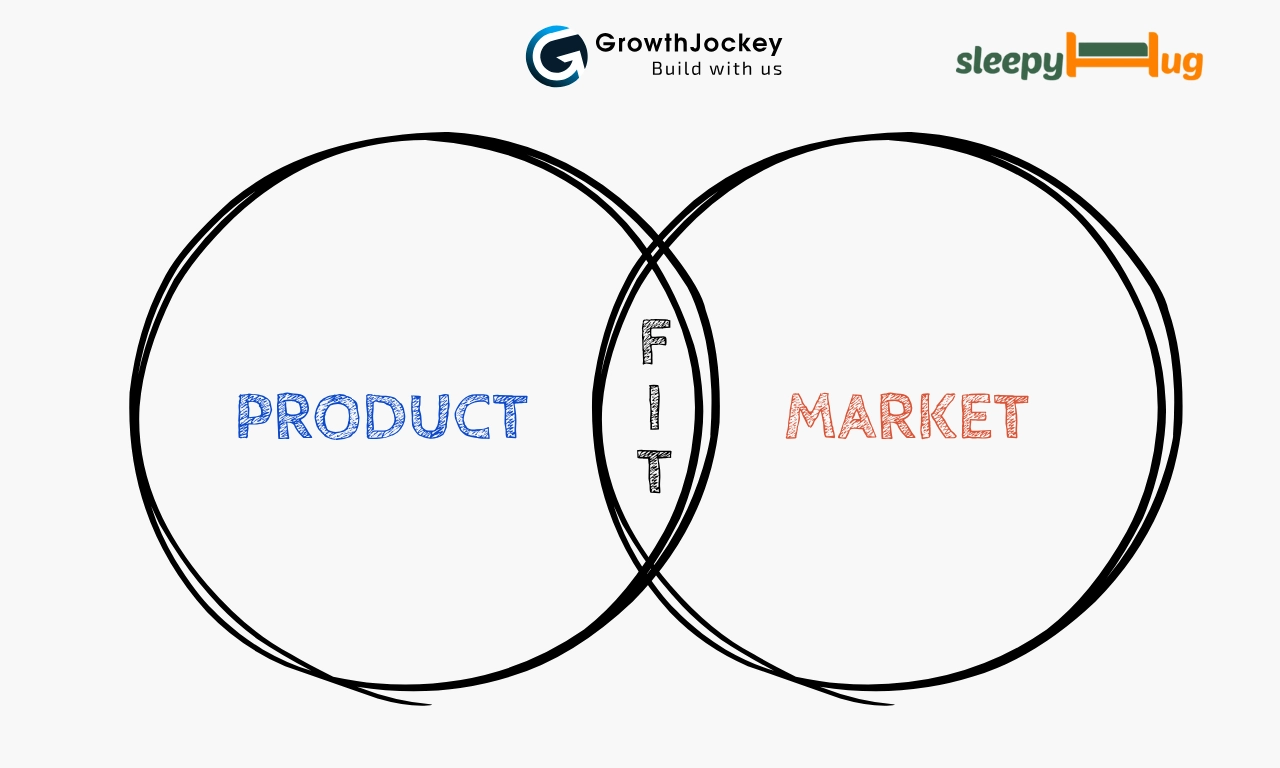Product-Market Fit: The Complete Guide with Frameworks & Strategies

Ever wondered why 90% of startups fail while that lucky 1-2% become unicorns? You might think it is better funding, smarter founders, or revolutionary tech.
Well, it's something far simpler - they achieved product-market fit before their competitors even knew what hit them.
You could have the most brilliant product in the world, but if it doesn't solve a real problem for real people willing to pay real money, you're building a monument to wishful thinking. And the graveyard of failed startups? It's full of these monuments.
So how do you know if you have PMF or if you're just fooling yourself? Let’s understand the product-market fit meaning and how you can use it to your advantage.
What is product-market fit (PMF)?
PMF full form in business is product-market fit, but it isn't some mystical state where everything suddenly clicks. So, what’s the PMF meaning? It's that inflection point where your product stops being pushed onto the market and starts being pulled by it.
When customers don't just use your product, but they can't imagine life without it.
Marc Andreessen famously described it as "being in a good market with a product that can satisfy that market."
Why PMF matters (before you scale)
Before PMF, you're convincing people to try your product. After PMF, they're convincing their friends.
Before PMF, every sale feels like pushing a boulder uphill. After achieving it, customers practically sell themselves.
That's the difference between a "good product" and one with true product-market fit is achieved when the market genuinely needs what you're building.
Without PMF, your burn rate becomes a countdown clock to failure. With it, every rupee spent on growth compounds. That's why achieving product-market fit is achieved when you focus on retention before acquisition.
Once PMF is real, build your go-to-market strategy so your scale isn’t temporary.
What are the different stages of product-market fit?
Stage 1 (Problem/insight): You're running JTBD interviews, validating that people actually have the painful job you think they do. No code, no product, just deep customer understanding. You're searching for that "aha" moment where customers lean forward and say, "Yes, exactly!"
Stage 2 (Solution/MVP): Your first version is live, targeting a razor-thin ICP. You're not trying to please everyone but just creating that first "aha" moment for a specific group. If 10 people absolutely love it, that beats 1000 who think it's okay.
Run your MVP through a stage-gate model to kill weak bets fast and double down on what users love.
Stage 3 (Early fit signals): Activation rates start climbing. Your cohort curves begin showing signs of life - they're not flat yet, but they're bending in the right direction. Users are sticking around longer than expected.
Stage 4 (PMF achieved): This is it - retention curves flatten at a healthy floor, word-of-mouth kicks in, and you feel the pull from the market. Sales cycles shorten. Customers expand without prompting. You know product-market fit is achieved when these signals converge.
Stage 5 (Scale): Now you can pour fuel on the fire. Add distribution channels, implement pricing tiers, and build competitive moats.
How to measure PMF - 2 different ways
Want to know if you have product-market fit? Here’s what you can use to figure out when is product-market fit is achieved:
1. PMF survey (Sean Ellis 40% rule)
Ask users one question: "How would you feel if you could no longer use [product]?" If 40% or more say "very disappointed," you're onto something.
But don't stop there. Segment the results. Understand why they'd be disappointed. Their answers become your product roadmap.
2. Retention cohorts (The Thermometer)
Plot your weekly or monthly cohort retention from the point of activation. What you're looking for? Curves that flatten to a stable floor. SaaS products might flatten at 80%. Social apps might be happy at 30%. The number matters less than the flattening.
Set up real-time analytics so PMF surveys and cohorts aren’t guesswork but live dashboards.
Why both PMF survey and retention cohorts?
The survey shows love. Retention proves habit. Love without habit is a fling. Habit without love is addiction. You need both for true product-market fit.
B2B companies should look for monthly cohorts that stabilise within 3-6 months. Consumer apps need weekly cohorts that flatten by week 8-12.
Different games, same principle: find your floor and defend it.
GrowthJockey's product-market fit framework (AI-driven + venture playbooks)
Wondering how to market a product? Forget the guesswork.
Here's how we systematically engineer product-market fit using AI and proven playbooks:
1. AI-driven ICP discovery
We don't guess who loves your product, we let the data tell us. By clustering survey responses with product-event data, our AI identifies segments with the highest retention and satisfaction.
These are behavioural clusters of users who get maximum value from your product. Use customer journey analytics with intellsys to map moments of value and build segment-specific nudges.
2. PMF survey (40% rule)
Run the Sean Ellis test. But here's the twist - segment responses by persona, use-case, and acquisition channel.
In a practical sense, this PMF meaning shows you've built something people can't live without.
3. Retention cohorts
Define your activation event, which is that moment when users first experience value. Then track weekly cohorts until they flatten.
Different verticals have different floors, but the pattern is universal: curves that flatten indicate product-market fit.
4. Action engine
Once you identify what users love, double down on that. You should also fix activation friction, reduce time-to-value, tighten pricing and packaging, and then re-measure.
Ship automation dashboards so teams can spot drop-offs daily and ship fixes without waiting for a quarter-end review.
It's a continuous loop of hypothesis, experiment, measure, learn.
5. Venture playbooks
Gate your roadmap with PMF metrics. No scaling spend until you hit the thresholds. No hiring spree until retention stabilises. This discipline separates winners from also-rans.
At GrowthJockey - a full-stack venture builder, we've codified these gates into playbooks that prevent premature scaling and help you with a PMF startup.
Product-market fit examples for inspiration
Let's see how product-market fit looks across different business models, with real success stories:
Sales-led B2B / product-led sales - Razorpay
Activation: Successful pilot running core workflows smoothly.
Retention lens: Account-level cohorts showing pilots converting to annuals, then expanding naturally.
Similarly, Razorpay nailed product-market fit with lightning-fast onboarding and developer-first APIs. Merchants could start accepting payments in hours and days.
They knew product-market fit is achieved when merchants started moving their entire transaction volume to Razorpay and adopting additional products like payouts and subscriptions without sales pushing them.
D2C / subscriptions - SleepyHug
Activation: First unboxing meeting quality promise, superior sleep experience from night one.
Retention lens: 90% organic sales ratio, customer testimonials driving word-of-mouth growth.
SleepyHug, incubated by GrowthJockey, knew that product-market fit is achieved when they solved India's sleep crisis with science-backed mattresses.
Their PMF signals: When organic sales hit 90% of total revenue and customers couldn't imagine sleeping without their AirCell cooling technology.
They tested 300+ mattresses, analysed thousands of reviews, and built orthopaedic support that actually worked.
The breakthrough came through their direct-to-consumer model, eliminating middlemen while maintaining premium quality.
They expanded from 39 to 500 SKUs, implemented AI-powered pricing through intellsys.ai, and achieved what most D2C brands dream of - ₹100 crore ARR. This proved that good product innovation combined with fair pricing creates powerful product-market fit in India's sleep wellness market.
Achieve PMF faster with GrowthJockey’s venture architects
Want to compress years of iteration into months? Here's our battle-tested approach to achieving product-market fit faster:
- AI-driven validation: Stop guessing what customers want. Cluster survey data to identify your segments with the highest satisfaction and retention.
- Activation engineering: Remove every friction point between signup and value. Implement seeded data, one-click templates, invite loops, and milestone nudges.
- Price/packaging fences: Align tiers to primary jobs-to-be-done. Keep it simple initially, as complexity kills conversion. You can always add sophisticated pricing once you have PMF.
- Venture playbooks: Gate spending and hiring behind PMF thresholds. Run monthly PMF councils where product, sales, and marketing align on metrics.
The companies that achieve product-market fit are systematic. They measure obsessively, iterate rapidly, and stay disciplined about not scaling prematurely.
Ready to accelerate your path to PMF? Get in touch with GrowthJockey's venture architects who have helped 25+ startups achieve product-market fit, with several reaching ₹100 crore ARR in year one. We combine AI-powered analytics with proven playbooks to compress your PMF timeline.
FAQs on what is product-market fit
Q1. What are the 4 types of market fit?
The four types include:
- Product-market fit (product solves market need)
- Product-channel fit (distribution matches product)
- Channel-model fit (economics work)
- Model-market fit (business model serves market)
Most critical is product-market fit.
Q2. What are the 4 stages of product-market fit?
1. Problem validation (confirming the pain exists), 2. solution validation (MVP proves value), 3. traction (early retention signals), and 4. scale (sustainable growth).
Q3. What is a good PMF score?
A PMF score of 40% or higher on the Sean Ellis test indicates strong product-market fit. But context matters - B2B products might need 50%+, while consumer apps could work with 35% if they have massive reach potential.
Q4. What is the difference between product fit and market fit?
Product fit means your product works well and solves a problem effectively. Market fit means there's actual demand and willingness to pay for that solution. True product-market fit requires both a great product that serves a hungry market.








